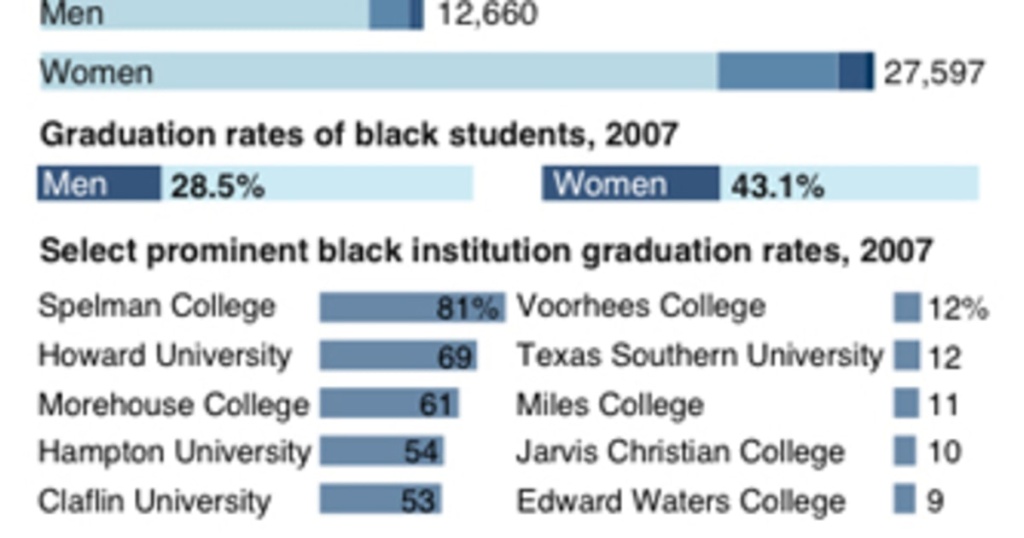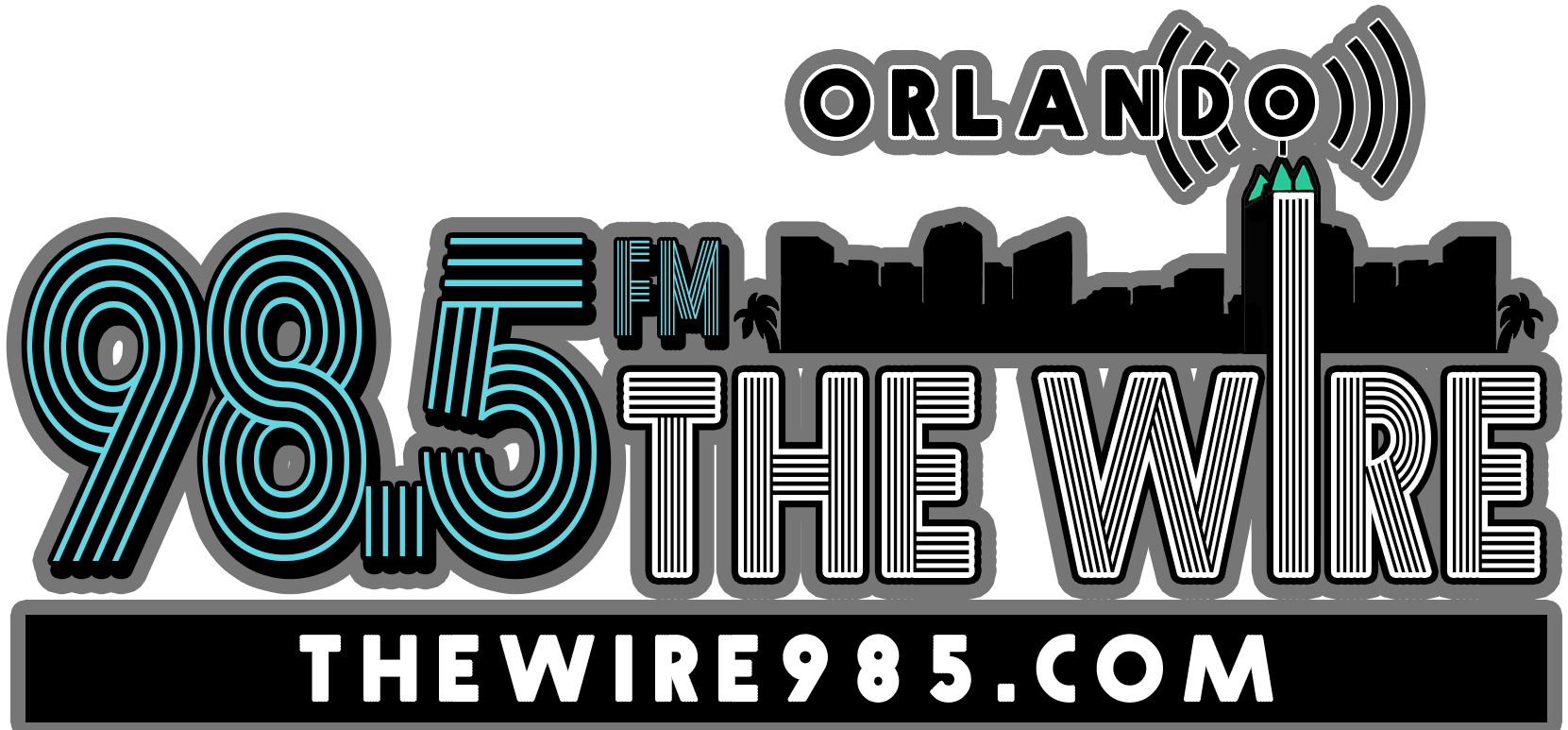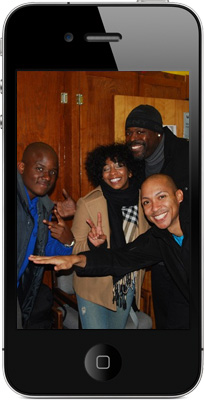Profile
Sections
tv
Featured
More From NBC
Follow NBC News
There are no new alerts at this time
They’re no longer the only option for African-American students, but the country’s historically black colleges and universities brag that they provide a supportive environment where these students are more likely to succeed.
That, though, is not necessarily true.
An Associated Press analysis of government data on the 83 federally designated four-year HBCUs shows just 37 percent of their black students finish a degree within six years. That’s 4 percentage points lower than the national college graduation rate for black students.
One major reason: the struggles of black men. Just 29 percent of HBCU males complete a bachelor’s degree within six years, the AP found.
A few HBCUs, like Howard and all-female Spelman, have much higher graduation rates, exceeding the national averages for both black and white students. But others are clustered among the worst-performing colleges in the country. At 38 HBCUs, fewer than one in four men who started in 2001 had completed a bachelor’s degree by 2007, the data show. At Texas Southern, Voorhees, Edward Waters and Miles College, the figure was under 10 percent.
To be sure, women are outperforming men across education, and many non-HBCUs struggle with low graduation rates. And the rates don’t account for students who transfer or take more than six years, which may be more common at HBCUs than at other schools.
Broad consequences
Most importantly, HBCUs educate a hugely disproportionate share of low-income students. Compared to other colleges defined by the government as “low-income serving,” HBCU graduation rates are just a few points lower. Factoring in obstacles like lower levels of academic preparation, some research suggests that HBCUs do as well with black students as do majority-white institutions.
Still, HBCUs’ low completion rates, especially for men, have broad consequences, on and off campus. Women account for more than 61 percent of HBCU students, the AP found. They have unprecedented leadership opportunities, but also pay a price — in everything from one-sided classroom discussions to competition for dates.
HBCUs educate only one-quarter of black college students, but produce an outsized number of future black graduate students and leaders. That group is distinctly female; HBCUs award twice as many degrees to women as to men.
The good news is some HBCUs are working hard to boost graduation rates — and succeeding. Experts say that proves failure isn’t inevitable — but also means it’s fair to ask tough questions of schools that are not improving.
HBCUs receive more than half their revenue from government. There is growing frustration with the waste of money — for students and taxpayers — when students have nothing to show for their time in college. President Barack Obama wants to return the United States to the top rank of college attainment by 2020. That will never happen if the colleges that do the heavy lifting of educating disadvantaged groups don’t perform better.
Even some within the tight-knit HBCU community say the schools bear some responsibility. They say too many HBCUs have grown content offering students a chance at college, but resisting the hard work to get them through.
“I think HBCUs have gotten lazy,” said Walter Kimbrough, president of Philander Smith College in Little Rock, Ark. “That was our hallmark 40, 50 years ago. We still say ‘nurturing, caring, the president knows you.’ That’s a lie on a lot of campuses. That’s a flat-out lie.”
‘Big Man on Campus’
Glancing around her classes at LeMoyne-Owen College in Memphis and in the stands at basketball games, sophomore Velma Maclin has noticed something odd. Most of the so-called “Big Men on Campus” are women.
“The ladies pretty much run the yard,” said Maclin. Several male friends recently got discouraged and dropped out. She has little sympathy. She works the overnight shift at FedEx Corp. and says if she can stay in school, they can, too.
Women have probably outnumbered men at HBCUs for most of their history, but the proportion has been gradually rising, the AP found — from 53 percent in 1976 to about 61 percent the last few years.
On 17 HBCU campuses there are two women for every man. At a few, the ratio is three-to-one.
“I don’t think any of us have put our finger on exactly why this seems to be exacerbating,” said Norman Francis, the longtime president of Xavier.
It sounds like easy living for men at HBCUs, and some joke about the advantages.
“You have so many beautiful women around you (that) you get to see and so many to pick from. The net is real wide,” laughed Eric Jefferson, a senior at North Carolina Central University in Durham, which is two-thirds women.
But while HBCU women are doing relatively well, many note the lack of gender diversity in their classes. The gender gap also weighs heavily on social life.
For many HBCU women, said Monet Phillips, an N.C. Central senior, the feeling is: “Even though that I’m the Monday woman, I’m going to be the best Monday woman so that when he’s with the Tuesday woman or the Wednesday woman then he’ll be thinking of me.”
Money matters
Like their counterparts at any college, HBCU women enjoy rewarding, lifelong friendships. But the competition for men can sometimes strain.
“It’s sad to say, but in the African-American community, it’s hard enough for women to get along without the issue of men,” said Bridgette Alexis, a LeMoyne-Owen freshman from Springfield, Mass. “You throw a small percentage of guys into the picture, and women who are looking and hoping to have boyfriends and relationships, and there’s not enough for everybody to have one. So that just makes the situation worse.”
Why do so many men drop out? Money is the reason you hear most. More than six in 10 students at the HBCUs the AP analyzed get Pell Grants, which go mostly to students from families earning under $30,000.
The faltering economy is hitting HBCU students hard. Fisk University in Nashville has lost 11 percent of its enrollment since August.
Another reason is preparation. On average, black students are less well prepared for college — and black men less so than women. The best black students are now also being recruited by majority-white institutions.
At Edward Waters, virtually every student takes developmental courses — essentially, to finish the high school education they never fully received. Only then can they start progressing toward a college degree.
Cultural factors
To explain the particular struggles of men, educators point to a range of cultural factors that affect black men everywhere, but which are especially visible at HBCUs.
Men have fewer role models, and also seem to think they have more opportunities without a degree. Educators also describe a constant battle against two poisonous ideas: that black men can’t succeed, or that if they do they are somehow less than genuine.
Tyshawn Johnson, 20, a junior education major at Claflin University in South Carolina, says it’s discouraging to see so few male faces on the campus, which is two-thirds female.
“When (men) come to school they think they’re never going to make it,” he said. “They start out and when they don’t think they’re up to snuff, they just quit. And that’s why females will always dominate the college ranks.”
There’s no silver bullet strategy for boosting graduation rates. But persistence helps.
Elizabeth City State University, a public HBCU serving a low-income corner of North Carolina, tries to identify who’s struggling and throw every possible resource their way. The best professors teach introductory and developmental courses. There are mandatory sessions to help students correctly apply for federal financial aid. When students drop out, ECSU calls them to find out what went wrong and try to persuade them to return.
The result is a graduation rate — around 50 percent — that substantially exceeds that of peers with similar student profiles.
New strategies, programs
At some HBCUs, there’s a growing recognition that some strategies need to focus specifically on men.
Last semester, Philander Smith established mentoring programs for men and aggressively recruited them. Some are simple: Students who came from homes without fathers never learned to tie a necktie, said Kimbrough, the president, and were embarrassed not to have one during chapel. So the school teaches them how.
Graduation rates have improved from the teens to near 30 percent.
“There’s still this idea that guys come to college, and if you need to help, you don’t ask for it. To me that’s the No. 1 barrier,” he said.
“A lot of students are coming with issues students didn’t even think about 30 years ago,” Kimbrough said. “Our jobs have changed. I think we have to be much more intrusive.”
‘Urgency varies’
UNCF, the United Negro College Fund, which represents 39 private HBCUs, said on its Web site the “average graduation rate at HBCU(s) is higher than the average graduation rate for African-Americans at majority institutions” — a claim that is contradicted, both for HBCUs and UNCF members, by the AP’s findings.
After inquiries from the AP, the organization removed that statement.
Karl Reid, UNCF’s senior vice president of academic programs and strategic initiatives, says the group is working with researchers at Morehouse College, an all-male HBCU in Atlanta, to find ways to help more black college men. It hopes to increase black male enrollment 20 percent at its member schools over the next five years, and to improve overall graduation rates 10 percent.
“There seems to be a groundswell that we’ve got to get this right,” Reid said. “Some schools get it.” But he acknowledged, “the urgency varies.”
Every HBCU has success stories — students like LeMoyne-Owen senior Jerome Heard. With his good looks, good manners and a dynamite singing voice, it’s hard to believe he had a 2.0 high school GPA. If LeMoyne-Owen hadn’t taken a chance on him, he says he’d still be working at the Hobby Lobby store back home in Chattanooga.
Here he has a 3.6 and was named “Mr. HBCU” in a national contest that crowns an informal HBCU student “king.”
“The teachers here just took me in and saw something in me, and said, ‘I think you will be successful,'” he said.
But the harsh reality is many HBCUs don’t have the resources to give every student that kind of attention.
Fixed on the experience
Howard and Spelman have endowments valued in the hundreds of millions, but Edward Waters has just $1.6 million. Flagship universities typically get the lion’s share of state funding over public HBCUs.
In a perfect world, say experts like Kevin Carey of the think-tank Education Sector, HBCUs would have more resources to spend on the toughest students. But they don’t, and “if you don’t have the resources to serve students, you’re not doing much good.”
“Some of these institutions … have struggled along for some time and have just tried to be available, an option for students, and have focused on the experience,” said Marybeth Gasman, a University of Pennsylvania historian of HBCUs. Many do heroic work with students others ignore, she said. But graduation rates below one-quarter won’t cut it in an era of tighter accountability.
“You have to keep in mind these students may be taking out loans and going into debt and still not get a degree,” she said.
Philander Smith’s Kimbrough says neither HBCUs nor any college should admit students if they don’t have the resources they need to get them through.
“I think it’s immoral to take someone when the indicators suggest this person is not going to graduate, and I don’t have anything special for them,” he said. “I’m just taking their money.”
© 2024 NBC UNIVERSAL
Men struggling to finish at black colleges – NBC News










More Stories
Trump Rescinds HBCU Support: A Dismantling Of Opportunity For Our Youth – Black Enterprise
Chinese Americans in Jim Crow South represented in ‘Sinners’ – AsAmNews
Former Dem congressman suggests Shedeur Sanders fell in NFL Draft because 'America fears strong black men' – Fox News